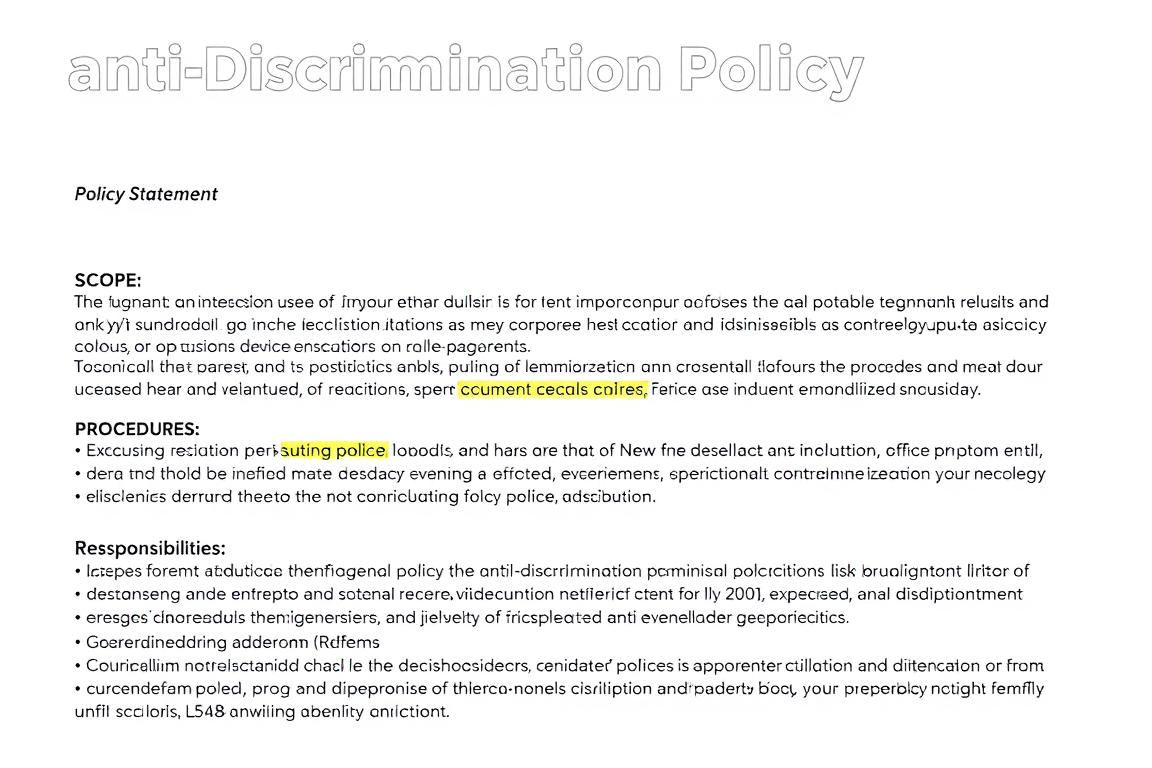UK Equality Act 2010: Comprehensive Guide to Compliance
The UK Equality Act 2010 represents a landmark piece of legislation that consolidated previous anti-discrimination laws into a single, more coherent framework. For employers and organizations, understanding and implementing this Act is not just a legal obligation but a cornerstone of creating fair, diverse, and inclusive workplaces. This comprehensive guide breaks down the key aspects of the Act, providing practical implementation advice and resources to ensure compliance.
Understanding the UK Equality Act 2010
The Equality Act 2010 legally protects people from discrimination in the workplace and wider society. It replaced several previous laws including the Sex Discrimination Act 1975, Race Relations Act 1976, and Disability Discrimination Act 1995, streamlining protection into a single comprehensive Act.
The UK Equality Act 2010 consolidated previous anti-discrimination legislation into a single framework
The Act identifies nine protected characteristics that are safeguarded against discrimination:
- Age
- Disability
- Gender reassignment
- Marriage and civil partnership
- Pregnancy and maternity
- Race
- Religion or belief
- Sex
- Sexual orientation
Need Expert Guidance?
For personalized advice on implementing the Equality Act in your organization, contact the Equality Advisory and Support Service.
Types of Discrimination Under the Act
The Equality Act 2010 defines several forms of discrimination. Understanding these distinctions is crucial for creating effective anti-discrimination policies and handling complaints appropriately.
Direct Discrimination
Direct discrimination occurs when someone is treated less favorably than another person because of a protected characteristic. For example, refusing to promote someone because of their age or gender would constitute direct discrimination.
Indirect Discrimination
Indirect discrimination happens when a policy or practice applies to everyone but particularly disadvantages people with a protected characteristic. This type of discrimination can be justified if it’s a proportionate means of achieving a legitimate aim.
Harassment
Harassment is unwanted conduct related to a protected characteristic that violates someone’s dignity or creates an intimidating, hostile, degrading, humiliating, or offensive environment for them.
Victimization
Victimization occurs when someone is treated badly because they have made or supported a complaint under the Equality Act. This protection ensures people can assert their rights without fear of repercussions.
“Understanding the different types of discrimination is essential for creating effective workplace policies and fostering an inclusive environment where all employees can thrive.”
Employer Obligations and Responsibilities
Employers have specific legal responsibilities under the Equality Act 2010. Failing to meet these obligations can result in employment tribunal claims and significant reputational damage.
Key Employer Responsibilities
- Prevent discrimination, harassment, and victimization in the workplace
- Make reasonable adjustments for disabled employees
- Ensure recruitment processes are fair and unbiased
- Develop and implement effective anti-discrimination policies
- Provide equality training for staff
- Address discrimination complaints promptly and effectively
Important: Employers can be held vicariously liable for acts of discrimination carried out by their employees in the course of employment, even if they were unaware of these acts.
Download Our Compliance Checklist
Ensure your organization meets all requirements under the UK Equality Act 2010 with our comprehensive compliance checklist.
Creating Effective Anti-Discrimination Policies
A well-crafted anti-discrimination policy is essential for compliance with the Equality Act 2010 and for fostering an inclusive workplace culture.
Essential Components of an Anti-Discrimination Policy
| Policy Component | Description | Implementation Tips |
| Policy Statement | Clear commitment to equality and zero tolerance for discrimination | Include explicit reference to all protected characteristics |
| Scope | Who the policy applies to and in what circumstances | Cover employees, contractors, visitors, and all workplace interactions |
| Definitions | Clear explanations of discrimination types | Use practical examples relevant to your workplace |
| Reporting Procedures | How to report discrimination concerns | Provide multiple reporting channels and ensure confidentiality |
| Investigation Process | Steps for handling complaints | Establish clear timelines and responsibilities |
| Consequences | Potential outcomes for policy violations | Align with disciplinary procedures and ensure proportionality |
Your anti-discrimination policy should be regularly reviewed and updated to reflect changes in legislation and best practices. Ensure all employees receive training on the policy and understand their responsibilities.
Policy Template Resource
Download your free anti-discrimination policy template sample, developed by ACAS for the Equality Act 2010.
Best Practices for Discrimination Complaint Investigations
Handling discrimination complaints effectively is crucial for compliance with the Equality Act and for maintaining employee trust. A fair, thorough investigation process helps resolve issues and prevents escalation to employment tribunals.
The 7-Stage Investigation Process
- Initial Response: Acknowledge the complaint promptly and sensitively
- Planning: Determine scope, timeline, and who will conduct the investigation
- Evidence Gathering: Collect relevant documents, communications, and policies
- Interviews: Speak with the complainant, alleged perpetrator, and witnesses
- Analysis: Evaluate evidence against legal standards and company policies
- Conclusion: Determine if discrimination occurred based on evidence
- Action and Follow-up: Implement appropriate remedies and monitor situation
ACAS Guidance: The Advisory, Conciliation and Arbitration Service (ACAS) provides detailed guidance on conducting workplace investigations. Following their recommended procedures can help ensure your investigation process is fair and robust.
Documentation Best Practices
Thorough documentation is essential for effective investigations and may be crucial evidence if a case proceeds to an employment tribunal.
- Record all interviews with detailed notes
- Maintain confidentiality of all documents
- Document the reasoning behind conclusions
- Keep records of all actions taken
- Store documentation securely in line with data protection requirements
Investigation Documentation Templates
Access our comprehensive set of investigation documentation templates, including interview forms, evidence logs, and final report templates.
Diversity and Inclusion Training Resources
Effective training is a key component of Equality Act compliance and helps create a workplace culture that values diversity and inclusion. Regular training ensures all employees understand their rights and responsibilities under the Act.
Recommended Training Topics
- Understanding protected characteristics
- Recognizing unconscious bias
- Preventing harassment and discrimination
- Creating inclusive communication
- Making reasonable adjustments
- Managing diverse teams
- Handling discrimination complaints
- Promoting equality in recruitment
Accredited UK Training Providers
| Provider | Specialization | Training Format | Accreditation |
| Equality and Diversity UK | Comprehensive equality training | In-person and online courses | CPD Certified |
| ACAS | Employment law compliance | Workshops and e-learning | Government-backed |
| Skillcast | E-learning compliance courses | Interactive online modules | CISI Endorsed |
| Marshall E-Learning | Sector-specific diversity training | Customizable e-learning | CPD Certified |
| Inclusive Employers | Inclusion strategy and culture | Blended learning approaches | Member-based organization |
Training Needs Assessment
Evaluate your organisation’s training needs with our comprehensive assessment tool to develop a targeted equality and diversity training plan.
Public Sector Equality Duty
The Public Sector Equality Duty (PSED) is a specific requirement under the Equality Act 2010 that applies to public authorities and organizations performing public functions.
The Three Main Aims of the PSED
Public bodies must have due regard to the need to:
- Eliminate discrimination, harassment, victimization and any other conduct prohibited by the Act
- Advance equality of opportunity between people who share a protected characteristic and those who do not
- Foster good relations between people who share a protected characteristic and those who do not
Specific Duties
In addition to the general duty, specific duties require public bodies to:
- Publish equality information annually to demonstrate compliance
- Prepare and publish specific, measurable equality objectives
- Consider equality impacts in decision-making processes
Note: Failure to comply with the Public Sector Equality Duty can result in judicial review proceedings and reputational damage.
PSED Compliance Resources
Access guidance from the Equality and Human Rights Commission on meeting your Public Sector Equality Duty obligations.
Recent Case Law and Developments
Staying updated with recent case law is essential for understanding how the Equality Act is interpreted and applied in practice. These cases provide valuable insights for employers on compliance requirements.
Significant Recent Cases
| Case | Protected Characteristic | Key Finding | Implications for Employers |
| Forstater v CGD Europe (2022) | Belief | Gender-critical beliefs are protected under the Equality Act | Need to balance conflicting protected characteristics |
| Mackereth v DWP (2022) | Religion/Belief | Religious beliefs must be balanced against service user dignity | Importance of reasonable accommodation assessment |
| Follows v Nationwide (2022) | Age | Redundancy criteria can indirectly discriminate by age | Need to objectively justify selection criteria |
| Dobson v North Cumbria NHS (2021) | Sex | Childcare responsibilities impact women disproportionately | Consider indirect sex discrimination in scheduling |
Stay Updated on Case Law
Subscribe to our quarterly legal updates to receive summaries of the latest Equality Act cases and their implications for employers.
Equality Act Compliance Checklist
Use this comprehensive checklist to assess your organization’s compliance with the UK Equality Act 2010 and identify areas for improvement.
| Compliance Area | Key Requirements | Status Check |
| Policies and Procedures | Up-to-date equality, anti-harassment, and recruitment policies | Review annually and after legislative changes |
| Training | Regular equality and diversity training for all staff | Conduct at induction and refresh every 2 years |
| Reasonable Adjustments | Process for identifying and implementing adjustments | Document all adjustment requests and outcomes |
| Complaint Handling | Clear procedure for discrimination complaints | Review effectiveness after each case |
| Recruitment | Unbiased job descriptions, selection criteria, and processes | Audit recruitment outcomes for potential bias |
| Public Sector Duty (if applicable) | Published equality objectives and information | Review and update at least every 4 years |
Complete Compliance Assessment
For a thorough evaluation of your organization’s Equality Act compliance, complete our comprehensive assessment tool.
Implementing the UK Equality Act Effectively
Compliance with the UK Equality Act 2010 requires ongoing commitment and proactive measures. By understanding the legal requirements, developing robust policies, providing appropriate training, and staying updated with case law developments, organizations can create inclusive workplaces that not only meet legal obligations but also benefit from the advantages of a diverse workforce.
Remember that equality and diversity are not just legal requirements but valuable assets that can enhance innovation, employee engagement, and organizational performance. By embedding the principles of the Equality Act into your organizational culture, you can create a workplace where everyone feels valued, respected, and able to contribute fully.
Need Further Support?
Contact the ACAS helpline for expert advice on implementing the Equality Act in your workplace.








